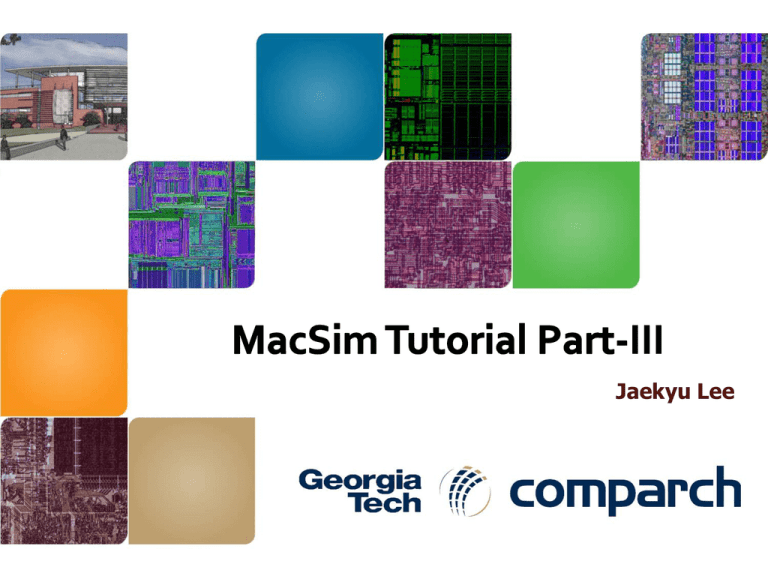MacSim Tutorial Part-III
advertisement

Jaekyu Lee
|
|
|
|
|
|
|
Source code directory structure
Trace Generation
Memory System
Process Manager
Data structures
Knobs and Stats
Debugging
MacSim Tutorial (In ISCA-39, 2012)
Jaekyu Lee
MacSim Tutorial (In ISCA-39, 2012)
MacSim Top-level
bin/
def/
doc/
params/
scripts/
src/
tools/
Build output directory
Contain definitions of parameter and events for statistics
Documentation (doxygen)
Include sample parameter configuration files
Scripts to build MacSim binary
Source files (.cc and .h)
Tools (x86 trace generator, trace reader, …)
// These files containing procedure to build and run MacSim and
SConstruct, Sconscript, buildy.py
// macsim-sst
Makefile.am
macsimComponent.cpp
macsimComponent.h
MacSim Tutorial (In ISCA-39, 2012)
MacSim Tutorial (In ISCA-39, 2012)
| Detailed MacSim class (members, hierarchy) information
| Doxygen url:
http://comparch.gatech.edu/hparch/macsim/doxygen/html/index.html
| Details in:
macsim/doc/macsim.pdf
MacSim Tutorial (In ISCA-39, 2012)
MacSim Tutorial (In ISCA-39, 2012)
| GPGPU traces
| X86 traces
| Graphics traces
(ongoing)
MacSim Tutorial (In ISCA-39, 2012)
CUDA code
(.cu)
NVCC
(Compiler)
GPUOcelot
Trace Generator
PIN
Trace Generator
X86 binaries
Open GL code
PTX code
PIN
(API Generator)
Attila
(OpenGL Emulator)
GPUOcelot
Trace Generator
Trace read
in MacSim
| Trace has following fields
PC, Opcode, Operands, Memory
addresses, Memory request size, Active
bits (to indicate divergent warp)
| Each thread (warp) has own file
with its thread id and block id
Trace_0.raw
Trace_1.raw
Trace_65536.raw
Trace_65537.raw
TID:
TID:
TID:
TID:
MacSim Tutorial (In ISCA-39, 2012)
0
1
65536
65537
BID:
BID:
BID:
BID:
0
0
1
1
| In MacSim, these trace
streams are converted to
internal RISC-style microops (uop)
| MacSim uses GPUOcelot for GPU trace generation
Ocelot Framework
X86TraceGenerator.cpp
libocelot.so
CUDA Source
NVCC
Compile
CUDA Object
libocelotTrace.so
NVCC
Linking
CUDA Executable
Trace for
MacSim
MacSim Tutorial (In ISCA-39, 2012)
Run Program
./fft 256 100 1 1
Trace.txt
Trace_0.raw
Trace_1.raw
…
Trace_N.raw
| Please refer to
http://code.google.com/p/gpuocelot/wiki/TraceGeneration (Ocelot)
http://code.google.com/p/macsim/wiki/TraceGeneration (MacSim)
Documentation in MacSim repository
1. Checkout GPUOcelot from subversion repository
svn checkout http://gpuocelot.googlecode.com/svn/trunk gpuocelot
2. Build Ocelot and Trace Generators
cd gpuocelot/ocelot; sudo ./build.py –install
cd gpuocelot/trace-generators; libtoolize; aclocal; autoconf; automake; ./configure;
make; sudo make install
MacSim Tutorial (In ISCA-39, 2012)
3. Link libocelot and libocelotTrace against CUDA applications
nvcc sourcefile.cu –locelot –ocelotTrace –lz –lboostxxx (boost libraries)
4. Turn on (Add) x86Trace knob in configure.ocelot file
// configure.ocelot
x86Trace: true
5. Run CUDA binaries to generate traces
./fft 256 100 1 1
MacSim Tutorial (In ISCA-39, 2012)
| Setting environment variables
TRACE_PATH : directory to store traces (default: current dir)
TRACE_NAME : prefix name for traces (default: Trace)
KERNEL_INFO_PATH : file that contains kernel information
COMPUTE_VERSION : compute capability
| Example
In ~/.bashrc
# Create a trace directory in the /storage/traces
export TRACE_PATH="/storage/traces/"
# kernel_info has the kernel information
export KERNEL_INFO_PATH="kernel_info"
# Calculate occupancy based on compute capability 2.0
export COMPUTE_VERSION="2.0"
MacSim Tutorial (In ISCA-39, 2012)
| The kernel information file (kernel_info) should contain the
following information.
kernel name
register usage (per thread)
shared memory usage (per thread)
(e.g.) _Z9Memcpy_SWPfS_i 14 52
| Running CUDA application creates a directory with the kernel
name where traces are generated as well as
kernel_config.txt which is used for MacSim.
drwxr-xr-x
-rw-r--r--
2 anonymous group 69632 Sep 00 22:03 _Z9Memcpy_SWPfS_i_0
1 anonymous group
66 Sep 09 22:29 kernel_config.txt
MacSim Tutorial (In ISCA-39, 2012)
| MacSim uses Pin for CPU trace generation
Optional
Source code
Compile
X86 binaries
PIN
Pintool
(in repository)
Run a program on top of PIN
pin –t trace_generator.so -- ./mcf inp.in
Trace for
MacSim
Trace.txt
Trace_0.raw
Trace_1.raw
…
Trace_N.raw
Download pintool (ver. 41150, June-7-2011), not backward compatible
Build trace generator in MacSim repository
cd macsim/tools/trace_generator; make
Run a program on top of PIN
pin –t trace_generator.so [options] – binary input
Pin homepage and tutorial: http://www.pintool.org
MacSim Tutorial (In ISCA-39, 2012)
| Traces are translated to internal RISC-style micro-ops
All traces are shared same structure
Defined in trace_read.h and trace_read.cc
| GPU traces: almost 1-1 matching
| CPU traces: simple translation
information is coming from Pin’s XED
XED provides Inst_category, register ids etc.
Does op have load/store?
Does op need a temp register?
Load+control flow, Load+store, load+no destination register
Does op have repeat?
Does op have a control flow instruction?
MacSim Tutorial (In ISCA-39, 2012)
Jaekyu Lee
MacSim Tutorial (In ISCA-39, 2012)
Default, IRIS
Ring, 2D mesh and torus
| Memory Controller
FCFS
FR-FCFS
Core
Core
Core
Private $
| Interconnection Network
Core
Private $
One or multiple levels
Highly flexible
Private $
Private $
| Cache hierarchy
Interconnection Network
Shared
MacSim class
// macsim.h
macsim_c {
memory_c* m_memory;
dram_controller_c** m_dram_controller;
router_wrapper_c* m_router;
};
Memory
Memory
Controller
Memory
Controller
Controller
$
| NoC and MCs are easily attachable/detachable with other
modules
MacSim Tutorial (In ISCA-39, 2012)
| Each cache level consists
Cache
Multiple queues
Banked
Multiple ports
Input Queue
Output Queue
Write-back Queue
Fill Queue
Router
MacSim Tutorial (In ISCA-39, 2012)
Input Queue
Memory class
// memory.h
dcu_c { // data cache
cache_c* m_cache;
port_c* WB
m_port[NUM_BANK];
Queue
queue_c*
queue_c*
queue_c*
queue_c*
m_in_queue;
Write-back
m_wb_queue;
m_fill_queue;
m_out_queue;
Banks/Ports
Access cache
Cache
Fill a cache line
Fill Queue
Cache misses
Output Queue
Router
router_c* m_router;
};
Outgoing/incoming
requests
| Cache operations and flows between queues
Cache access
Input Queue
Cache eviction
Banks/Ports
Access cache
Outgoing requests
WB Queue
Write-back
Cache line fill
Cache
Fill a cache line
Fill Queue
Cache misses
Output Queue
Router
Outgoing/incoming
requests
MacSim Tutorial (In ISCA-39, 2012)
| To model various cache hierarchy models, we employ very
flexible cache hierarchy
Input Queue
Banks/Ports
| We need to define
Cache has a router
WB Queue
Cache
Fill Queue
Output Queue
Router
If router is enabled, traffics between
upper/lower caches are thru the router
Cache has a direct link between upper/lower cache
Otherwise, there must be a direct link
between caches
MacSim Tutorial (In ISCA-39, 2012)
// cache constructor
dcu_c(
int id,
Unit_Type type,
int level,
memory_c* mem,
int noc_id,
dcu_c** next,
dcu_c** prev,
macsim_c* simBase);
Cache constructor
//
//
//
//
//
//
//
//
cache id
core type
level
pointer to
router id
pointer to
pointer to
pointer to
the memory system
upward cache
downward cache
simulation base class
// cache initialization function
void dcu_c::init(
int next_id,
// downward cache id
int prev_id,
// upward cache id
bool coupled_up,
// has direct link to upward cache
bool coupled_down, // has direct link to downward cache
bool disable,
// cache disabled?
bool has_router);
// has router?
MacSim Tutorial (In ISCA-39, 2012)
Cache initialization
| 2-level private cache with the direct link
L1
| L1 does not have router
| L1 miss
Input Queue
Banks/Ports
WB Queue
Cache
Fill Queue
Output Queue
Router
| L2 hit
L2
Insert data directly into L1’s fill queue
| L2 miss
Input Queue
Banks/Ports
WB Queue
Inserted directly into L2’s input queue
Cache
Fill Queue
Output Queue
Router
Go thru L2’s router
L1 fill – Insert data directly from L2’s fill
queue to L1’s fill queue
next_id, prev_id, coupled_up, coupled_down, disable, has_router
i,
-1,
false,
true,
false,
false)
-1,
i,
true,
false,
false,
true)
l1Cache[i]->init(
l2cache[i]->init(
MacSim Tutorial (In ISCA-39, 2012)
| Private L1, L2 caches with Shared L3 cache (No direct link)
L2
| L2 miss
Input Queue
Banks/Ports
WB Queue
Cache
Fill Queue
Output Queue
Router
Go thru L2’s router
| L3 hit
Go thru L3’s router to feed data to L2
| L3 miss
L3
Input Queue
Banks/Ports
WB Queue
Cache
Go thru L3’s router
L2 fill – Go thru L3’s router to feed data to
L2
Fill Queue
next_id, prev_id, coupled_up, coupled_down, disable, has_router
l1cache[i]->init(
i,
-1,
false,
true,
false,
false)
Output Queue
Router
l2cache[i]->init(
-1,
i,
true,
false,
false,
true)
l3cache[i]->init(
MacSim Tutorial (In ISCA-39, 2012)
-1,
-1,
false,
false,
false,
true)
| Private L1, L2 caches with Shared L3 cache (With direct link)
Shared L3 has multiple tiles (bank)
L2
| L2 miss
Input Queue
Banks/Ports
WB Queue
L3
Cache
Fill Queue
Output Queue
Router
Destination: local tile – Use direct link
Destination: distant tile - Go thru L2’s router
| L3 hit
Destination: local tile – use direct link
Destination: distance tile - Go thru L3’s
router to feed data to L2
Input Queue
| L3 miss
Banks/Ports
WB Queue
Cache
Go thru L3’s router
Fill Queue
next_id, prev_id, coupled_up,
coupled_down,
disable,
Local L2
fill – use direct
link has_router
l1cache[i]->init(
i,
-1,
false,
true,
false,
false)
Output Queue
Router
true,
Distant L2 fill
– Go thru
L3’s router
l2cache[i]->init(
-1,
i,
true,
false,
true)to feed
data to L2
l3cache[i]->init(
MacSim Tutorial (In ISCA-39, 2012)
-1,
i,
true,
false,
false,
true)
| We provide sample cache hierarchies
Users need to specify single parameter to use sample classes
No cache - NVIDIA G80 GPU architecture
Private L1 / Shared L2 - NVIDIA Fermi GPU architecture, Intel Core
architecture
Private L1, L2 / Shared+tiled L3 with direct link - Intel Sandy Bridge
architecture
Private L1, L2 / Shared+tiled L3 without direct link - Generic 2D topology
Parameter: <string> KNOB_MEMORY_TYPE
class
class
class
class
no_cache_c
l3_coupled_network_c
l3_decoupled_network_c
l2_decoupled_network_c
MacSim Tutorial (In ISCA-39, 2012)
//
//
//
//
no cache
3-level,
3-level,
2-level,
Sample memory classes
architecture (NVIDIA G80)
direct link (Intel Sandy Bridge)
no direct link (General 2D topology)
no direct link (NVIDIA Fermi)
| Default bi-direction ring network
Pipelined router architecture
Model virtual and physical channels with arbitrations
| IRIS interconnection simulator
CASL research group (Georgia Tech, led by Prof. Yalamanchili)
Model more detailed features
Have various topologies (Ring, 2D Mesh, Torus, …)
MacSim Tutorial (In ISCA-39, 2012)
| We model DRAM banks and channels
| DRAM bandwidth is modeled
| 3 timing parameters
Activate, Precharge, Column Access
| Scheduling policies
FCFS, FR-FCFS
Other policies can be easily
implementable
MacSim Tutorial (In ISCA-39, 2012)
// dram.h
class dram_controller_c {
address_parsing
dram_request_buffer,
banks,
channels,
router,
...
};
DRAM controller
pseudo code
| Request Merging
Memory requests with the same address can be merged with other
older requests in various locations
Intra-core: MSHR
Inter-core: DRAM request buffer
| Coalesced vs. Uncoalesced
If GPU SIMD threads generate memory requests contiguous address,
multiple requests can be coalesced in a larger request
We model coalescing in Trace Generator
GPUOcelot provides memory address and access size for each thread
of a warp (block)
MacSim Tutorial (In ISCA-39, 2012)
MacSim Tutorial (In ISCA-39, 2012)
| We use term the “Process” for an application in MacSim
| A Process consists of one or more threads (thread blocks)
| Process Manager is the component of MacSim that assigns
work to cores
| It also handles creation/termination of process/threads
(thread blocks)
Bookkeeping to track number of running threads, completed threads
MacSim Tutorial (In ISCA-39, 2012)
| Single process simulation
Process
Process
Process
Thread
Threads
Blocks of
Warps
Single-threaded
Application
Multi-threaded
Application
Multi-threaded
GPU Application
MacSim
MacSim Tutorial (In ISCA-39, 2012)
Single-threaded CPU
Multi-threaded CPU
GPGPU
| Multi-process simulation
Any combination of processes
| Configuring Multi-process
simulations
Partition cores among
applications
Specify the number of threads
(thread blocks) per core
Specify repetition flag
| Allocate process structure, read trace config file and
determine when threads have to be created
main thread created at start up
points of creation of child threads specified in terms of number of
instructions executed by main thread
as the main thread executes check if a child thread should be created, if so,
create the child thread and mark it ready for execution
for GPGPU applications all warps are created and marked ready at
start up
MacSim Tutorial (In ISCA-39, 2012)
On application start up
create_process()
read_trace()
in trace_read.cc
create_thread_node()
Create dummy thread node for
scheduling. Actual creation of
thread (memory allocation, ..)
happens when a thread is
scheduled to a core
insert_thread()/
insert_block()
Insert dummy node to pending queue
m_thread_queue /
m_block_queue
MacSim Tutorial (In ISCA-39, 2012)
data structures
During execution main thread
spawns child threads
| CPU
Greedy assignment of threads to cores
Each core assigned threads up to user specified limit
| GPU
Scheduling at thread block granularity - all warps in a block assigned to same core
Greedy assignment of blocks to cores (other policies can be added easily)
Occupancy - How many blocks per core?
Calculated using Ocelot at trace generation and passed to Mascim via traces
Can be overridden by user
| Once assigned threads/thread block remain on the same core until
termination
| Multi-application simulations (CPU+CPU or CPU+GPU),
Each application is restricted to a statically defined set of cores
Can repeat short running applications until a long running application ends
MacSim Tutorial (In ISCA-39, 2012)
| Process Manager maintains queues of ready but unassigned
threads/thread blocks
X86 Queue
T4
X86
Core
X86
Core
T3
GPU Queue
T2
X86
Core
T1
X86
Core
max threads per core = 2
T3
GPU
SM
T2
T1
GPU
SM
T3
GPU
SM
T2
T1
GPU
SM
T3
T2
T1
GPU
SM
max thread blocks per core = 2
| Initially – greedy assignment to
cores until specified limit
| Initially – greedy assignment to cores
until specified limit
| Thereafter - assign a new thread to
a core whenever a thread on the
core terminates
| Thereafter - assign a new thread block
to a core only when the core retires
an entire thread block
MacSim Tutorial (In ISCA-39, 2012)
GPU
SM
Called to assign threads (blocks) to
core
sim_thread_schedule()
GPU
CPU
sim_thread_schedule_block()
Determine block to be
assigned to core
fetch thread id
from queue
m_thread_queue
m_block_queue
data structure
data structure
Repeat until all warps
in block are assigned
Core
Assign thread / warp to core
MacSim Tutorial (In ISCA-39, 2012)
| Consists of two files
process_manager.h/cc
| process_manager.h
Declares Process Manager class
process_manager_c
Defines data structures for
Applications being simulated
process_s
Warps on GPU cores / threads on CPU cores
thread_s
Bookkeeping
block_schedule_info_s
thread_trace_info_node_s
MacSim Tutorial (In ISCA-39, 2012)
| process_manager.cc
Defines member functions of process_manager_c class
MacSim Tutorial (In ISCA-39, 2012)
| thread_s
structure analogous to task structures used in OS kernels (task_struct
in Linux)
each CPU thread and GPU warp has an instance of thread_s
contains fields for
thread id, block id, pointer to trace file, process to which thread/warp
belongs, instructions read, trace buffer
In GPU cores, thread id represents warp id
MacSim Tutorial (In ISCA-39, 2012)
| thread_s
typedef struct thread_s {
int
m_thread_id; /**< current thread id */
int
m_block_id; /**< block id */
gzFile
m_trace_file; /**< gzip trace file */
bool
m_file_opened; /**< trace file opened? */
bool
m_main_thread; /**< main thread (usually thread id 0) */
uint64_t
m_inst_count; /**< total instruction counts */
uint64_t
m_uop_count; /**< total uop counts */
bool
m_trace_ended; /**< trace ended */
process_s
*m_process; /**< point to the application belongs to */
bool
m_ptx; /**< GPU thread */
char*
m_buffer; /**< trace buffer */
frontend_s*
m_fetch_data; /**< frontend fetch data */
trace_info_s*
m_prev_trace_info; /**< prev instruction trace info */
trace_info_s*
m_next_trace_info; /**< next instruction trace info */
bool
m_thread_init; /**< thread initialized */
trace_uop_s*
m_trace_uop_array[MAX_PUP]; /**< trace uop array */
trace_uop_s*
m_next_trace_uop_array[MAX_PUP]; /**< next trace uop array */
} thread_s;
MacSim Tutorial (In ISCA-39, 2012)
| process_s
one instance for each application being simulated
common structure for both CPU and GPGPU applications
GPGPU applications do not include CPU-side traces, they only include traces
from all kernels executed by the application
has fields for process id, start info of threads, no. of threads (warps)
in application, threads (warps) created, threads terminated (warps),
list of valid cores for this application, list of kernels executed by
application (GPGPU only)
MacSim Tutorial (In ISCA-39, 2012)
| process_s
typedef struct process_s {
process_s();
~process_s();
unsigned int
m_process_id; /**< current process id */
int
m_orig_pid; /**< original process id - in case of repetition */
int
m_max_block; /**< max blocks per core for the application */
thread_start_info_s *m_thread_start_info; /**< thread start information */
thread_s**
m_thread_trace_info; /**< thread trace information */
unsigned int
m_no_of_threads; /**< number of total threads */
unsigned int
m_no_of_threads_created; /**< number of threads created */
unsigned int
m_no_of_threads_terminated; /**< number of terminated threads */
map<int, bool>
m_core_list; /**< list of cores that this process is executed */
queue<int>
*m_core_pool; /**< core pool pointer */
bool
m_ptx; /**< GPU application */
int
m_repeat; /**< application has been re-executed */
vector<string>
m_applications; /**< list of sub-applications */
vector<int>
m_kernel_block_start_count; /**< block id start count for sub-appl. */
string
m_current_file_name_base; /**< current sub-appl.'s filename base */
string
m_kernel_config_name; /**< kernel config file name */
int
m_current_vector_index; /**< current index to the sub-application */
map<int, bool>
m_block_list; /**< list of block currently running */
uns64
m_inst_count_tot; /**< total instruction counts */
int
m_block_count; /**< total block counts */
} process_s;
MacSim Tutorial (In ISCA-39, 2012)
| block_schedule_info_s
bookkeeping structure for thread blocks in a GPGPU application, one
instance for each thread block
contains fields for no. of warps in block, no. of terminated warps, core
to which block is assigned
typedef struct block_schedule_info_s {
bool
m_start_to_fetch;
/**< start fetching */
int
m_dispatched_core_id; /**< core id in which this block is launched */
bool
m_retired;
/**< retired */
int
m_dispatched_thread_num; /**< number of dispatched threads */
int
m_retired_thread_num; /**< number of retired threads */
int
m_total_thread_num;
/**< number of total threads */
int
m_dispatch_done;
/**< dispatch done */
bool
m_trace_exist;
/**< trace exist */
Counter m_sched_cycle;
/**< scheduled cycle */
Counter m_retire_cycle;
/**< retired cycle */
} block_schedule_info_s;
MacSim Tutorial (In ISCA-39, 2012)
| thread_trace_info_node_s
wrapper structure around thread_s used by process_manager_c to
track threads (warps) yet to be assigned to cores
typedef struct thread_trace_info_node_s {
thread_s* m_trace_info_ptr; /**< trace information pointer */
process_s* m_process;
/**< pointer to the process */
int
m_tid;
/**< thread id */
bool
m_main;
/**< main thread */
bool
m_ptx;
/**< GPU simulation */
int
m_block_id;
/**< block id */
} thread_trace_info_node_s;
MacSim Tutorial (In ISCA-39, 2012)
| process_manager_c
creates processes, threads (warps)
does assignment of threads / thread blocks to cores
invoked again on termination of threads (warps)
contains list of threads not assigned to any core (CPU only)
contains list of threads blocks not assigned to any core (GPGPU only)
handles repetition of applications (triggered by retire) when multiple
applications are being run
MacSim Tutorial (In ISCA-39, 2012)
| Process/Thread creation and termination
// allocates process_s node, reads config file and determines no.
// of threads/warps and thread blocks in application / each kernel
// of application, start info of threads
create_process()
// called for each thread/warp when it becomes ready for launch,
// allocates a thread_trace_info_node_s node and inserts into
// m_thread_queue or m_block_queue. All warps are ready for launch
// at the start of a kernel
create_thread_node()
// allocates and initializes a thread_s node, opens trace file
// for thread/warp
create_thread()
// cleans up some data structures and saves stats (if this the
// first run of the application)
terminate_process()
// clears data structures, retires thread block if all warps in
// block have completed, calls sim_thread_schedule()
terminate_thread()
MacSim Tutorial (In ISCA-39, 2012)
| Thread/block scheduling
// assigns a thread to a core or a thread block to a core if the
// number or threads/blocks on the core are fewer than the maximum
// allowed
void process_manager_c::sim_thread_schedule(void);
// called by sim_thread_schedule() to determine the next block
// that will be assigned to a core
int process_manager_c::sim_thread_schedule_block(int core_id);
// inserts thread / thread_block into list of threads / blocks yet
// to be launched
void process_manager_c::insert_thread(thread_trace_info_node_s*)
void process_manager_c::insert_block(thread_trace_info_node_s*)
MacSim Tutorial (In ISCA-39, 2012)
Nagesh Lakshminarayana
MacSim Tutorial (In ISCA-39, 2012)
| uop_c
main data structure for uops
an instance is allocated for each uop
contains thread (warp) id, core id, block id (GPU only), timestamps of
when uop passed through different stages, opcode type, source and
destination operands and all other information required for execution
contains list of child uops in case of uncoalesced memory accesses
| New uops are allocated from a uop pool and completed uops
are returned to the pool
MacSim Tutorial (In ISCA-39, 2012)
| core_c
class for cores in simulation
contains pointers to objects for pipeline stages and components
during simulation run_a_cycle() of core_c is called every cycle
core_c::run_a_cycle() calls run_a_cycle() function of the pipeline stages
MacSim Tutorial (In ISCA-39, 2012)
| map_c
Class for tracking data and memory dependences between uops of a
thread
once a dependence between uops is identified, pointer to source uop
is added to the list of uops on which the dependent will wait
in the schedule stage a check is made to see if all sources of a uop have
completed
MacSim Tutorial (In ISCA-39, 2012)
| mem_req_s
data structure for memory requests
an instance of mem_req_s is allocated for every memory request
contains id information, details of primary memory request and
piggybacking requests, pointer to done function
done function is a callback function called when the memory request is
completed (actually when response reaches L2)
user can add code here for collecting statistics
MacSim Tutorial (In ISCA-39, 2012)
| drb_entry_s
data structure for requests in DRAM
contains timestamp, row id, bank id and pointer to memory request
requests to a bank are held in a list, DRAM scheduler sorts this list
according to policy being implemented and returns the head of the list
can extend the structure to track any information that your DRAM policy
requires
MacSim Tutorial (In ISCA-39, 2012)
Nagesh Lakshminarayana
MacSim Tutorial (In ISCA-39, 2012)
| pool_c
class used to implement memory pools of objects/strctures of different
types
acquire_entry() and release_entry() for getting/releasing an from/to the
pool
pool expands automatically when it is out of space
| pqueue_c
class for modeling latencies of pipeline stages
entries pushed into the queue are ready to be removed from queue after
the specified latency
priority used among entries pushed into queue in the same cycle
MacSim Tutorial (In ISCA-39, 2012)
| Factory classes
Fetch policies, DRAM policies, memory hierarchies and so on are
implemented by classes whose objects are instantiated via factory
mechanisms
One factory class for fetch policies, one for DRAM policies, …
For supporting new policies
Define a class for the policy
Register class with factory under the name of the policy
Specify new policy as the policy to be used during simulation (via
simulation parameters)
MacSim Tutorial (In ISCA-39, 2012)
Nagesh Lakshminarayana
MacSim Tutorial (In ISCA-39, 2012)
| Used to specify architecture and simulation parameter values
| Available knobs can be found in .param.def files in def/
directory under main source directory
| To set a knob
provide a value on the command line (highest priority),
provide a value in the parameter file, or
provide a default value in the definition (lowest priority)
| All knobs and their values for a simulation are written to
params.out file when simulation starts
MacSim Tutorial (In ISCA-39, 2012)
| Add a definition in a relevant .param.def file in def/ directory
(create a new file if necessary)
Knob definitions converted into c++ source and included in build
process automatically
| Format of definition
param<{name_in_code}, {name}, {knob_type}, {default_value}>
name_in_code – name for accessing knob in the code (in upper case)
name – name used in command line or parameter file (in lower case)
knob_type – bool, different int types, float, string
default value must be provided
| Example definition
param<L2_ASSOC, l2_assoc, int, 8>
MacSim Tutorial (In ISCA-39, 2012)
| Example definition
param<L2_ASSOC, l2_assoc, int, 8>
| Setting value on command line
./macsim --l2_assoc=16
| Setting value in parameter file (params.in)
l2_assoc 16
| Accessing in code
use KNOB_L2_ASSOC (prefix knob name with KNOB_)
*m_simBase->m_knobs->KNOB_L2_ASSOC, or
m_simBase->m_knobs->KNOB_L2_ASSOC->getValue()
MacSim Tutorial (In ISCA-39, 2012)
Nagesh Lakshminarayana
MacSim Tutorial (In ISCA-39, 2012)
| Global or per core stats
| Three Stat types supported
COUNT
RATIO
#occurrences of an event
Ratio of #occurrences of event A to the #occurrences of event B
DIST
Proportion of each event in a group of events
| Stat definitions can be found in .stat.def files in def/
directory under main source directory
MacSim Tutorial (In ISCA-39, 2012)
| At the end of simulation .stat.out files containing stat values
are generated
single application simulation - .stat.out files
Multi-application simulation - .stat.out.<appl_id> files
stat files generated when the first run of application completes
| Script to read stat values from the stat files will be provided
provide name of stat and value of stat will be printed
script can also evaluate simple expressions containing stat names
MacSim Tutorial (In ISCA-39, 2012)
| Format of definition
DEF_STAT(STAT_NAME, COUNT, NO_RATIO [, PER_CORE])
STAT_NAME – name for accessing stat in code (in upper case)
NO_RATIO – not a ratio stat
PER_CORE – optional, use if you want a per core stat
| Example definitions
DEF_STAT(INST_COUNT_TOT, COUNT, NO_RATIO)
DEF_STAT(INST_COUNT, COUNT, NO_RATIO, PER_CORE)
| Example output
INST_COUNT_TOT
INST_COUNT_CORE_0
INST_COUNT_CORE_1
MacSim Tutorial (In ISCA-39, 2012)
100000
52342
47658
100000
52342
47658
Count
Count
| Format of definition
DEF_STAT(STAT_NAME, RATIO, BASE_STAT_NAME [, PER_CORE])
STAT_NAME – name for accessing stat in code (in upper case)
BASE_STAT_NAME – stat whose value is the denominator in the ratio
PER_CORE – optional, use if you want a per core stat
Requires the definition of a stat of type COUNT
| Example definition
DEF_STAT(DCACHE_ACCESSES, COUNT, NO_RATIO)
DEF_STAT(DCACHE_HITS, RATIO, DCACHE_ACCESSES)
| Example output
DCACHE_ACCESSES
DCACHE_HITS
67258
8434
Count
MacSim Tutorial (In ISCA-39, 2012)
67258
0.123
Count
Ratio = (8434 / 67258)
= (#DCACHE_HITS/#DCACHE_ACCESSES)
| Format of definition
DEF_STAT(STAT_NAME_START, DIST, NO_RATIO [, PER_CORE])
DEF_STAT(STAT_NAME, COUNT, NO_RATIO [, PER_CORE])*
DEF_STAT(STAT_NAME_END, DIST, NO_RATIO [, PER_CORE])
DIST stat should contain at least two stats
| Example definition
DEF_STAT(ICACHE_HITS, DIST, NO_RATIO)
DEF_STAT(ICACHE_MISSES, DIST, NO_RATIO)
| Sample output
ICACHE_HITS
ICACHE_MISSES
292331
34767
Count
MacSim Tutorial (In ISCA-39, 2012)
0.8937
0.1063
Proportion = (292331 /(292331 + 34767)) = 89.37%
Proportion = (34767 /(292331 + 34767)) = 10.63%
Σ(propi) = 1 = 100%
| Macros for updating Stats
Global stats
STAT_EVENT(STAT_NAME) – increment STAT_NAME by 1
STAT_EVENT_N(STAT_NAME, n) – increment STAT_NAME by n
STAT_EVENT_M(STAT_NAME) – decrement STAT_NAME by 1
Per-core stats
STAT_CORE_EVENT(CORE_ID, STAT_NAME) – increment STAT_NAME for
core CORE_ID by 1
STAT_CORE_EVENT_N(CORE_ID, STAT_NAME, n) – increment STAT_NAME
for core CORE_ID by n
STAT_CORE_EVENT_M(CORE_ID, STAT_NAME,) – decrement STAT_NAME
for core CORE_ID by 1
MacSim Tutorial (In ISCA-39, 2012)
Nagesh Lakshminarayana
MacSim Tutorial (In ISCA-39, 2012)
| Debug statements can be printed only with the debug
version of the MacSim binary
Run “make dbg” to build the debug version
| To output debug statements for a stage/component
Set knob debug_cycle_start to the cycle value from when debug
statements should be printed
Cycle value should be greater than zero
Set the debug enable knob for the stage/component to 1
Knobs available for pipeline stages, memory system and so on
Check debug.param.def for list of available knobs
| Knob debug_cycle_stop can be set to turn off debug
statements after some point
Set debug_cycle_stop to zero (default) to print till end of simulation
MacSim Tutorial (In ISCA-39, 2012)
| params.in file with debugging enabled for front-end stage
…
debug_cycle_start 1
debug_cycle_stop 0
debug_front_stage 1
…
MacSim Tutorial (In ISCA-39, 2012)
| Debug statements can be added using the DEBUG macro
| DEBUG macro takes parameters similar to the printf()
function
| Example debug statement
DEBUG("m_core_id:%d thread_id:%d uop_num:%lld operands are
not ready \n",
m_core_id, cur_uop->m_thread_id, cur_uop->m_uop_num);
MacSim Tutorial (In ISCA-39, 2012)
MacSim Tutorial (In ISCA-39, 2012)
| A Forward Progress Error is triggered when an active core
has not retired any instructions for the number of cycles
specified by the knob forward_progress_limit
A Forward Progress Error causes simulation to be aborted
| A Forward Progress Error could be triggered when
A uop cannot be retired because the memory request it generated was
lost in the memory system
A uop cannot be scheduled because one of its sources operands is not
marked ready yet, but the uop producing the source has already
retired (or is lost)
MacSim Tutorial (In ISCA-39, 2012)
| The knob bug_detector_enable can be turned on to
generate additional debug information that would be helpful
in resolving forward progress errors
Works with both debug and optimized versions of binary
Generates
bug_detect_uop.out
Dump of all uops in the pipeline of the failing core
bug_detect_mem.out
Dump of all memory requests issued by the failing core
bug_detect_dram.out
Dump of all requests in DRAM
MacSim Tutorial (In ISCA-39, 2012)
Questions?
MacSim Tutorial (In ISCA-39, 2012)






